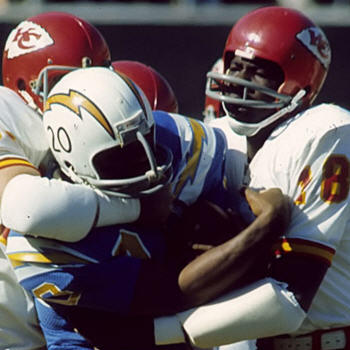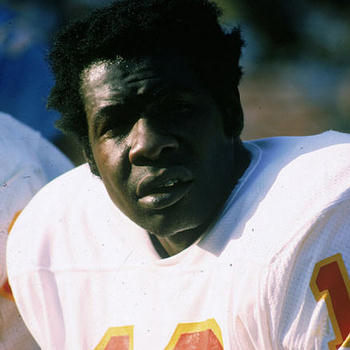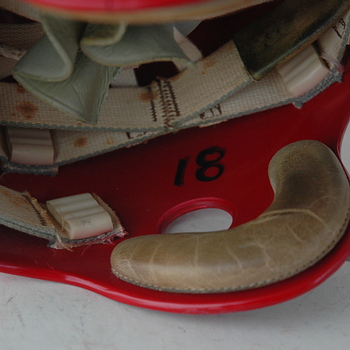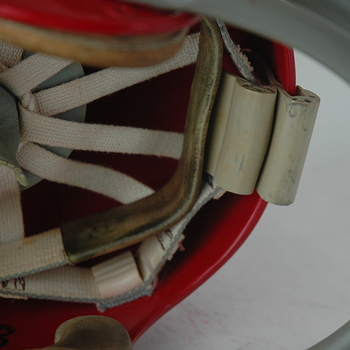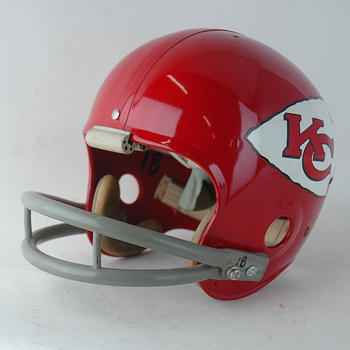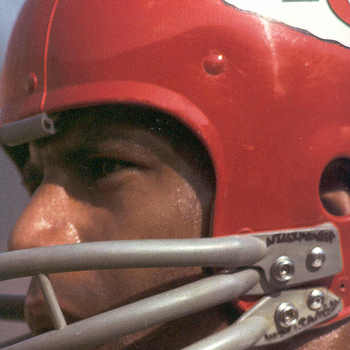
KC CHIEFS
Emmitt Thomas
(Game Worn)
The great Kansas City Chiefs defensive back Emmitt Thomas can be
considered one of the most illustrious graduates of both Abraham
Barrington Marshall High School in his home town of Angleton,
Texas and Bishop College. Obviously through no fault of Thomas,
both institutions closed after he had brought honor to their
athletic programs, Marshall to the integration of the Angleton
school district and Bishop College to financial difficulty and
declining enrollment. The Chiefs of course still stand tall and
Thomas stands among the tallest of all Chiefs who wore the
uniform of this storied American Football League and NFL
franchise. Known more for his offensive acumen in high school
and college, Thomas came to the Chiefs in 1966 primarily on the
recommendation of super scout Lloyd “Judge” Wells who was so
influential in helping to stock the Chiefs with African American
players from the Historically Black Colleges of the South and
Southwest. Thomas however, wasn’t necessarily seeking a
professional football career, much less one draped with honor,
with baseball as his first love. He stated that “I played
baseball, football and ran track at Bishop College.
Unfortunately, they didn’t have a great baseball program so I
switched over to football and dedicated most of my time to
that.”
Thomas was a
bit hamstrung adapting to the professional game his first
season, undergoing the transition many rookies make and both he
and fellow corner back Fletcher Smith were the only rookies to
make the Chiefs 1966 active roster. “Most of us coming from
predominantly Black schools didn’t play a lot of combination
coverages. We played what’s called Cat Defense. ‘You go cover
that cat, I’ll cover this cat,’ that’s how we played. We played
against some outstanding athletes…that really helped us cover so
effectively as pros.” Another of the Chiefs defensive backs,
James Marsalis, coming to Kansas City a few years later in 1969
as the AFL Defensive Rookie Of The Year from Tennessee State,
played the same style of football as Thomas. Both Emmitt and
Marsalis utilized that coverage experience to become the major
proponents of what was called the Bump And Run manner of
coverage.
Thomas was an
immediate standout on special teams. He averaged over
twenty-three yards per kickoff return his rookie season, the
only time he performed this duty for the Chiefs, and was a
fearless tackler going downfield. It took him a while to break
into the starting line-up and by-pass starter Willie Mitchell
but he snared four interceptions in his second season and his
professional career took off from there. The very physical
man-to-man skills utilized by Thomas resulted in an
extraordinary career, one that spanned thirteen seasons and
earned him a boatload of accolades. He was named to a total of
five AFL All Star or NFL Pro Bowl squads, was a First or Second
Team All Pro on four occasions, and has managed entry to both
the Chiefs and Pro Football Halls Of Fame. He played at a
consistent level of excellence, picking off nine passes in the
Chiefs Super Bowl winning season of ’69 and leading the NFL with
twelve INT’s in 1974 during his ninth season. He completed his
career in 1978 looking back as the franchise all time
interception leader with fifty-eight picks and a retired jersey
number.
Although he made an
indelible mark in football as a player, Emmitt Thomas continued
to work in the sport that used to hold second-place status to
baseball, spending two seasons as an assistant coach at Central
Missouri State, and then returning to the NFL as an assistant
who eventually rose to the Defensive Coordinator position for
the Packers, Vikings, and Falcons. He remains as the Chiefs
defensive backfield coach, a spot he’s held since 2010. This
great player and exceptional man that has held the respect of
teammates and all of those he has coached, can be easily
recalled by looking at his 1971 Kansas City Chiefs helmet.
Thomas’ Riddell TK shell is equipped with the ubiquitous
standard Riddell gray two bar mask with the “personal touch” so
often given to the protective wear the Chiefs donned by
equipment manager Bobby Yarborough. Inspection of Emmitt’s mask
makes obvious the handwritten number 18 on the right side of the
facemask. Another Yarborough customization was Emmitt’s
double-snubber utilizing Gladiator parts for this specific item
rather than the usual Riddell snubbers. He often used shoulder
pad rivets in the Chiefs helmets for repair or replacement and
just as often these were painted over as is obvious on this
piece of football history. The shell carries a nicely aged yet
well preserved Chiefs decal and Yarborough noted the yearly code
on the shell’s interior.
This beautifully preserved piece of Chiefs history is reflective
of one of the team’s greatest players, one who perhaps remains
underrated and underappreciated by too many fans despite being a
member of the Pro Football Hall Of Fame.



